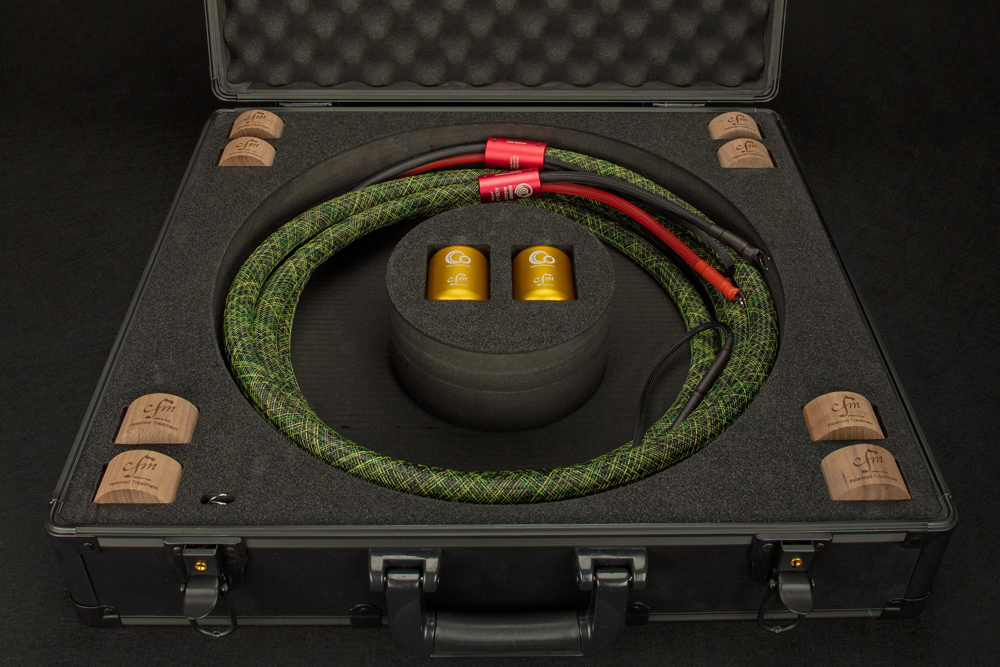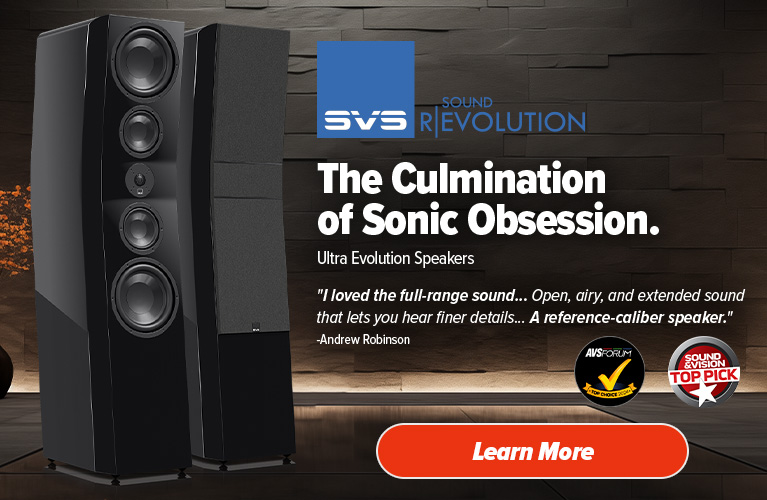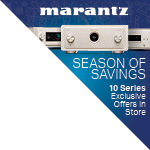Cables for Music. I like that. Like, wine for the palate or… lens transcribing for subjective vision. A tangible thing which acts as a conduit to interpretive personal pleasure. As far as our audio universe, unadulterated music is the ultimate target, right? In this examination of the ‘Resonant’ cable loom from innovative Hong Kong specialist Cables for Music, I embark on a multi-faceted installation process arriving at a unique cable architecture. Or cable system. One which its makers have painstakingly crafted to deliver the purest version of… well, the last word on the company’s very name. It’s a noble foundation.
Cables for Sure
Cables for Music’s founder Calvin Law has some very specific ideas about the importance of the cable interface structure within the context of an audio system. Not just in terms of electrical signal transmission but also regarding the inter-correlation of materials and a cable’s association with the environment in which it inhabits. When he contacted me sometime in late 2020 regarding a review of his Resonant creations from the Ultra High-End line, Law suggested a truer sense of their potential would be achieved if handled as an interface ‘system’ by way of a complete loom. The review process would also involve the introduction, one-at-a-time, of the various ‘tweaky’ upgrade elements offered as add-ons. I’ll go into further detail as to what these additional components are below.
Early in 2021, a large and heavy box arrived with enough Cables for Music (CfM for short) products to completely cater to just about every signal and AC power component in my system. The loom included appropriate lengths of interconnecting cable of both RCA and XLR varieties, copper-heavy loudspeaker cables, RCA S/PDIF coaxial and AES/EBU digital interfaces and enough AC power cables to juice-up every component. For each cable type, I was sent standard-design cables, featuring the company’s comprehensive in-built shielding techniques, in addition to versions with a connectivity option to CfM’s ‘Earth Grounding Cables’ and ‘Mega Earth Grounding Distributor’ system. The grounding-upgradeable cables feature an off-shoot cable tail terminated with banana socket at one end and banana plug at the other. When used without the ‘Earth Grounding Cables’ the two ends terminate by simply plugging into each other. The loom provided did not include a USB cable for streamer/server to DAC nor a DIN to RCA phono cable.
Due to the Resonant cables being components in a CfM ecosystem, Law sent me explicit setup instructions down to pair-matching stereo cables via lengthy serial numbers. Further, the CO-P2, which is an add-on upgrade has been tuned to a specific cable which, again, requires serial number matching. And despite instructions to physically isolate each standard (red) Cable Optimiser and the add-on CO-P2, Law refutes mechanical/physical and vibrational interaction reasons but, rather, attributes his techniques to a proprietary solution he expands on below.
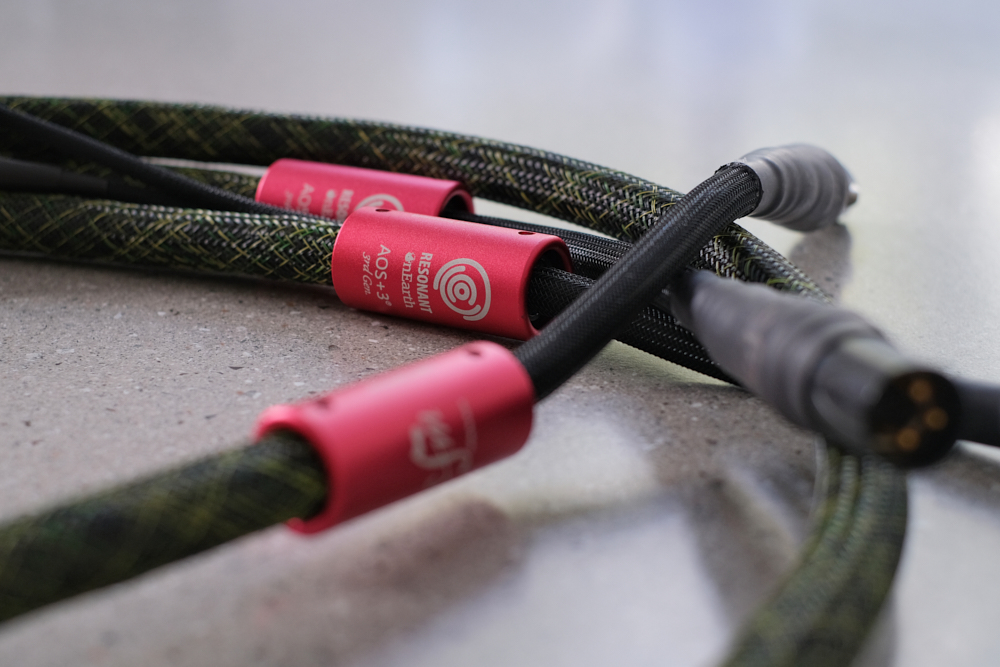
Conductor material is high grade “pure copper” used across the entire cable line. Interestingly, while of course Law places high importance on conductor material, its quality and inherent purity, he also considers other aspects of cable design to play as important a part. More on that below.
CfM adopts high quality connectors, with the AC power cables featuring Furutech plugs while interconnect and digital cables sport Neutrik XLRs and Furutech RCAs (both can be optioned with upgraded Cardas connectors). Loudspeaker cables were sent, as requested, with banana plugs at the amplifier end and spades at the loudspeaker end. Again, connector quality was very good. Overall, the Resonant cables build quality is evidently high. They are distinctively styled in a high quality speckled dark green outer jacket which, as far as my RAM memory banks can retrieve, seems to be of a unique design.
All cable types feature CfM’s patented Advanced Optimised Shielding Plus (AOS+3) third generation three-layer copper braid shielding architecture. From there, the company’s ‘OnEarth’ grounding technology can be added on via dedicated ground cables and interface boxes. However, the review samples were provided with the necessary OnEarth cable adaptor/tails but not the grounding hardware. Phew! There’s enough to talk about in terms of other schemes I’ll be introducing below so we’ll leave the OnEarth grounding technology for another day.
Calvin Law explained some of Cable for Music’s core design principles and technologies:
We have developed a series of procedures for testing all the materials and identifying the best ways to use them with different kinds of treatment. As such, all materials being used in a cable should have consistent sonic character. We would not use any materials that we cannot test and then treat them satisfactorily. This is indeed our black technology.
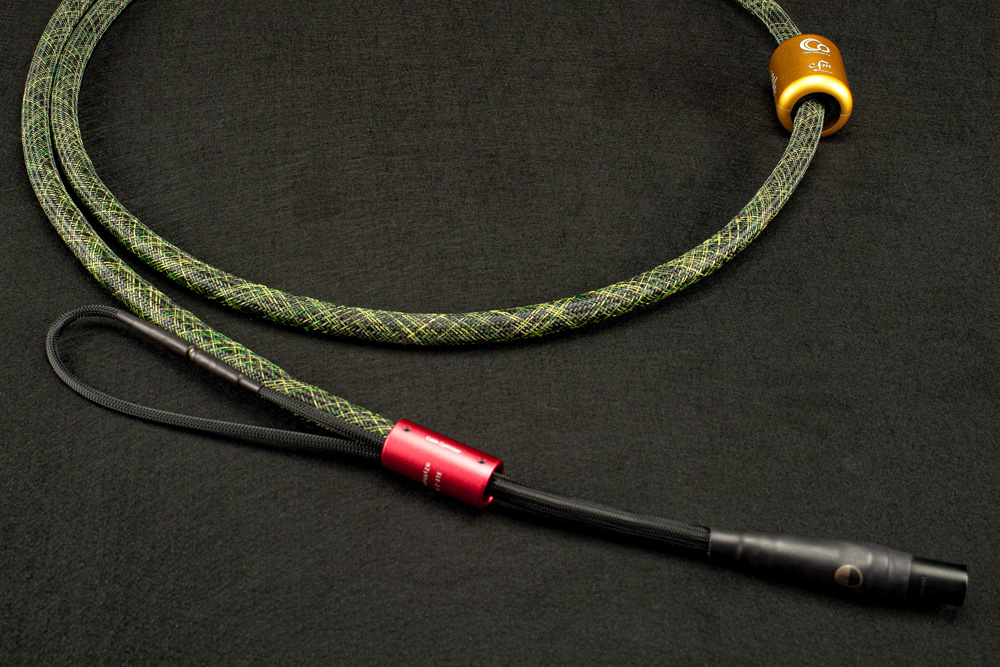
A core part is our patented Optimised Shielding technology which can greatly reduce the adverse effect of the electrical conductor from the pure copper shielding structure. Therefore, this technology can allow us to successfully apply multiple-layer shielding structure. Normally, the higher density of metal shielding structure, greater the adverse effect to the conductor. Our technology can effectively optimise that and retain the nett shielding benefits. However, there are some cable manufacturers who have given up using shielding. We absolutely don't agree that. We prove that the sound quality can be improved by enhancing the shielding capability with our technology. We actually use the same conductor from the Beat to Resonant series and they sound different without any confusion from series to series. Higher the series, significantly better the 3D soundstage, sonic details, dynamics and most importantly the musicality.
Each cable is made under precise calibration for each shielding layer during the production processes. For the multiple-layer shielding structure, we have the whole cable manufactured starting from a single piece of bare wire building it layer by layer. It is rather time consuming to build a cable especially the Resonant and Melodious cables. Resonant adopts the AOS+3 three-layer shielding structure using six-discrete-layer structure, three pure copper layers with three ultra-thin insulation layers built one by one with precise calibration made for each pure copper shielding layer.
Our design philosophy is to build cables without any tonal character. That is very important to ensure the reflection of the true potential of the components and system being connected.
Our core technology is for optimised shielding capability that definitely relies on the quality earth ground source to improve the shielding quality. However, all of our standard cables should use the ground sources from the components, in which, the ground quality is much deteriorated due to their operation. We avoid using the ground sources from any components directly with the OnEarth version cables.
So, what are the add-ons here? For starters, the Resonant line is supplied with CfM’s raw walnut wooden block support system. According to Calvin Law, the blocks feature a proprietary “treatment” aimed at tuning the signal in order to enhance the cables’ performance. By Law’s law, the blocks should be placed the right way up and with the CfM logo facing the ground source. Moving the supports along the cable length is claimed to change the soundstage and imaging presentation as does turning them slightly. As far as the treatment the blocks are subjected to, Law would only share that it’s a proprietary procedure and has received extensive testing and measurements. Law expanded:
One of our typical experiences is that the speaker cables lying on a floor would not sound good. It is not the physical (mechanical/vibration) issue. Therefore, we have used tools to support them and enhance the performance or in another way to minimise the adverse effect from the floor. However, the remaining problem is that the support tool still touches the cable bodies and affect the sonic characters of the cables. I believe that the solution is to provide the support tools with the same kinds of sonic characters. Finally, we decided to choose raw walnut wooden blocks that has virtually neutral sonic character. We need to test each wooden blocks and treat them correctly for obtaining the required sonic character. As we are capable to correctly test and treat all materials, electronically conductive or non-conductive, we know how to treat and enhance the best possible sonic character.
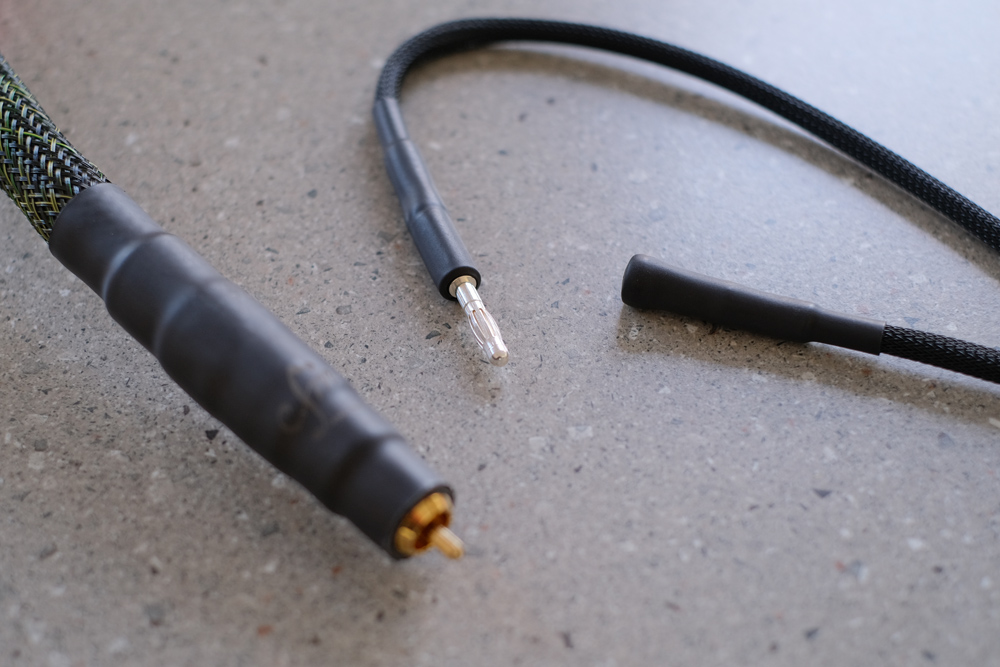
Additional elements to these distinctive cables are the red cylinders located close to the termination lead-outs and also further along the cables’ body. CfM calls these ‘Cable Optimisers’ and they are supplied as standard fare with the Resonant cables (and have been since Gen-2). These tune the sound and must not touch any other surface, according to Law’s law. However, further improvements are claimed to be had via a much larger version referred to as ‘Cable Optimiser Pro 2 (CO-P2), a gold-coloured cylindrical collar which attaches around the cable. The CO-P2 is available to suit cable diameters between 16mm and 22mm while a larger version adapts to 23mm to 29mm cable gauges. Law suggests the position of the CO-P2 along the cable’s length, its orientation and the tightness of the Allen-head bolting system, which couples the collar’s two-halves, influence the sound. They should also not touch any other surface. I did experiment with all this – results below. Again, Law provides his take:
In general, the improving effect is nothing related to physical matters such as magnetic or vibration consideration. Nevertheless, some audiophiles would regard these as a vibration matter. It is indeed purely the complicated interaction between the materials being coupled. Actually, we always use different tools to support components, these are also the materials’ coupling effects instead of so-called mechanical effects. We first developed the red cable optimisers with our testing and special treatment for each unit. They are firstly used for laser engraving any logo and product details and secondly provide the 360 degree effect to the cable body which can significantly enhance the sonic characters of the cable. Further, we develop a more effective Cable Optimiser Pro CO-P1 for Songbird and CO-P2 for Rhythm and higher series. Unlike the standard red Cable Optimiser, only one CO-P1 or CO-P2 can be used on each cable for best results.
When you put the CO-P2 on other cables following the required direction, you will basically find the sound quality enhanced. However, the best performance is also related to how the Cable Optimiser acts on the cable body. Therefore, we provide the CO-P1 or CO-P2 being customised for each cable depending on its size by providing the best fit for the best possible fine tuning range for each cable. If users follow the recommended tuning angle, they will get significant sonic improvements with much better 3D soundstage and detail. I liken it to adjusting the VTA of a tonearm. Once they are finely tuned well, the performance is amazing.
Law’s final thoughts were quite critical in terms of referencing his company’s truest ethos and also reflect the man’s own passions:
My philosophy is that without revealing the best performance of a system, we’re just listening to good sound, at best, but not the music. We always emphasise that our cables can help reveal the real performance potential of the components or systems to a level they may not have experienced before with other cables. As such, I name the company Cables for Music; the cables are not simply for delivering sound but music. On our website’s ‘Home’ page we use an image of a cable with a violin not an audio system or component.
I therefore focus on improving the performance of the connected components to obtain real music enjoyment. Many of our customers agree that once they use our cables, they find them much more enjoyable than upgrading the components. One of the major benefits of the Resonant cables is the ultra-wide frequency response which can deliver exceptional 3D soundstage with excellent detail. As such, the high frequencies are silky smooth, while the bass is rigid and very deep with ultra-high definition that is not muddy or excessive.
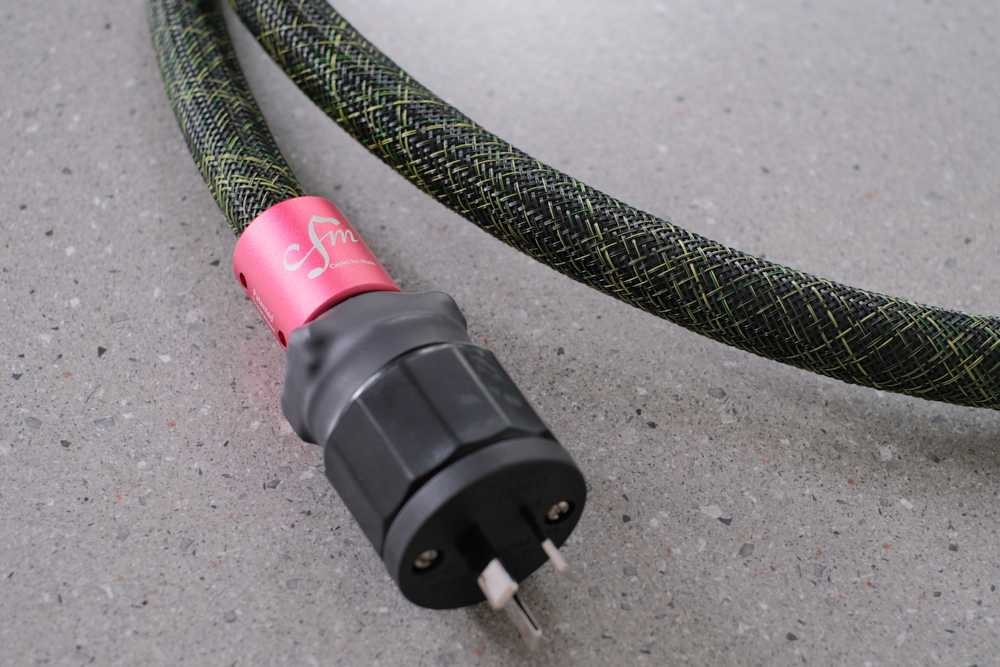
So, that wraps the descriptions of the cables and the add-ons supplied for this review. Both my descriptions and their maker’s. Overall, the cable setup is unlike any other I’ve experienced – and I’ve reviewed truck-loads. The add-ons are certainly unique elements to the Cables for Music products but they’re nothing too challenging in terms of installation, which nevertheless requires some attention and compliance to instructions. Of course, once done it can be set-and-forget… or not.
The Cable Optimisers (both types) and the wooden block supports, including the very specific cable matching and orientation suggestions, are rife for controversy and audio forum flame wars. You know, the ones between objectivists and subjectivists. Me? Hey, life’s too short. I keep well away from such banter which, sadly, often becomes toxic. Popcorn anyone?
Music for Cables
The initial stage as far as my evaluations was to simply introduce the entire loom into the system context. From there, I would introduce the wooden support blocks. The third and final stage would adopt the CO-P2 Cable Optimisers. All Law’s instructions were carefully followed – serial numbers matched, component orientation and positions carefully assessed and adjusted. Needless to say this was the most complex cable architecture I’ve ever encountered. I must stress again, however, that once tuned to the user’s liking, it’s done and dusted – you can get on with Super Terrific Happy Hour music listening.
The Resonant cables, to summarise in one sentiment, are… spacious. If you’re the type of listener who appreciates a wide, deep and tall soundstage populated with focused images, then these are the cables for you. Trust me. Ditto if you treasure musicality over Hi-Fi-ness. Seldom have I seen a company’s name so profoundly encapsulating its products’ conveyance. Resonant cables are a passage to music.
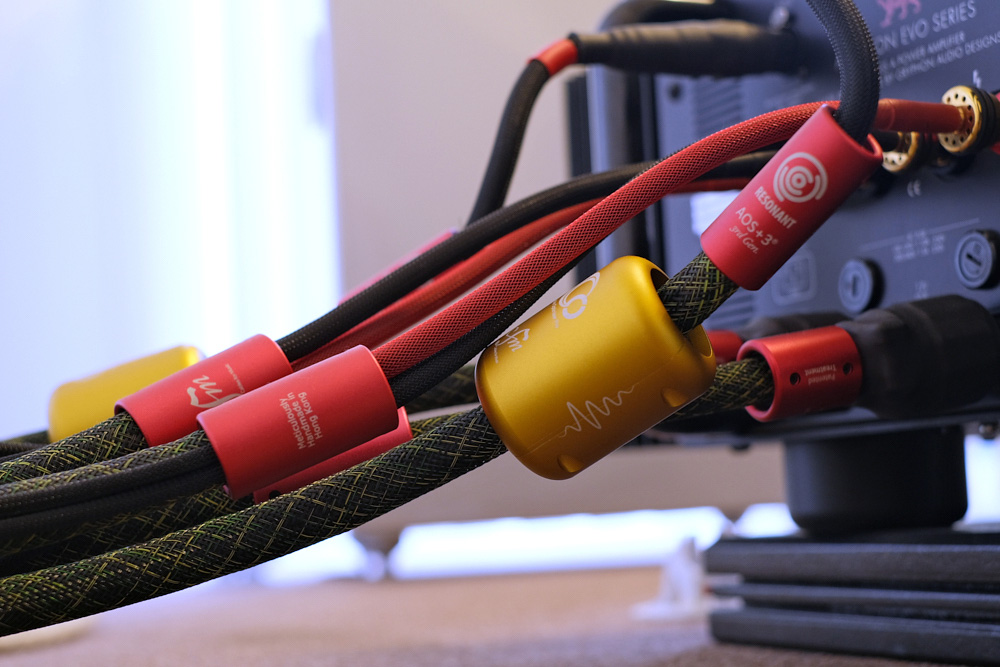
So I’ll touch on that aspect first, as I found that to be the one outstanding trait the Resonant loom exhibited at the outset. If you read my reviews you’ll know that, as far as soundfield testing, Ani DiFranco’s “Amazing Grace” from the superb live album Live in Clip gets regular spins. The sense of being in a massive venue is almost spooky. You’re immersed in the crowd and hear distant shouts, whistles and coughs in addition to the acoustic signature of the venue itself. With Resonant, all that is amplified – pun intended – to another level. The venue seems larger, the crowd noises further in the distance, the envelopment all the greater.
You can expect the same sonic field vastness from Harry Belafonte’s Live at Carnegie Hall where the master performer can be heard to move around the massive stage while the CfM cables beautifully capture the ambience of the iconic venue. With some cables, Belafonte’s vocals can sometimes sound a tad sharply-sibilant. Not with the Resonant loom in place – there was a simply natural and lifelike vocal range reproduction, whether male or female.
Yes, “Natural reproduction” is yet another wonderful feature of the Resonant loom. All instruments, especially acoustic ones, sound utterly real in terms of their inherent tonal signature. This is of utmost importance if you’re to believe what you are hearing. Sure, as far as Hi-Fi, the illusion never totally lives up to reality, but man, with these cables you get close. I loved “Watson Blues” from Aussie maestro Tommy Emmanuel’s Accomplice One album. Finger-pickin’ good and in total control of his instrument. Emmanuel’s plucks and strums are all translated without smear or confusion, allowing the leading edge attack of forcefully-played notes to ‘jump’ out of the mix. Ringing true, the guitar’s metal strings buzz and whiz.
While on approaching reality, dynamics are always a giveaway that you’re listening to a Hi-Fi system, not real instruments. No cable can give you more, wider dynamic expression than what is in the recording and the capabilities of the electronics and loudspeakers. They can, however, inhibit explosiveness if some cable design aspect is off-kilter. The Resonant cables were not a bottleneck here. If there’s drama and pyrotechnics in the music, then Resonant will, um… resonate true. No stunting, no crippling of dynamic expression here.
Ergo, the epic splendour of Holst’s “Mars The Bringer of War” from The Planets, on Decca’s classic capture with Charles Dutoit conducting Orchestre Symphonique de Montréal, shows an authentic barrage of power. As do the cannon’s on Telarc’s 1812 with Erich Kunzel conducting the Cincinnati Pops Orchestra. Man, when they fire… mind the volume knob or you’ll end-up with a diaphragm on your lap. Or wear armoured PPE.
The intimacy of ensemble Jazz, acoustic World and Chamber music is effortlessly conveyed by the Resonant cables. You get the impression of being more closely connected to the musicians and their instruments. There’s a solidity and body to images which are always appropriately focused while also demonstrating superb immediacy. The beauty of the soundtrack for the criminally underrated movie The Fountain and its thematic cello and violin motif was almost heartbreaking.
Ditto for other emotive music such as the exquisite tonality and harmonic decay of the piano accompanied by the detailed mellowness of the stand-up bass on Dane duo Bremer/McCoy’s Utopia, the sheer wonder and palpability of Masaa’s voice on Irade and on, and on. All of these stunning recordings were nothing short of… credible.
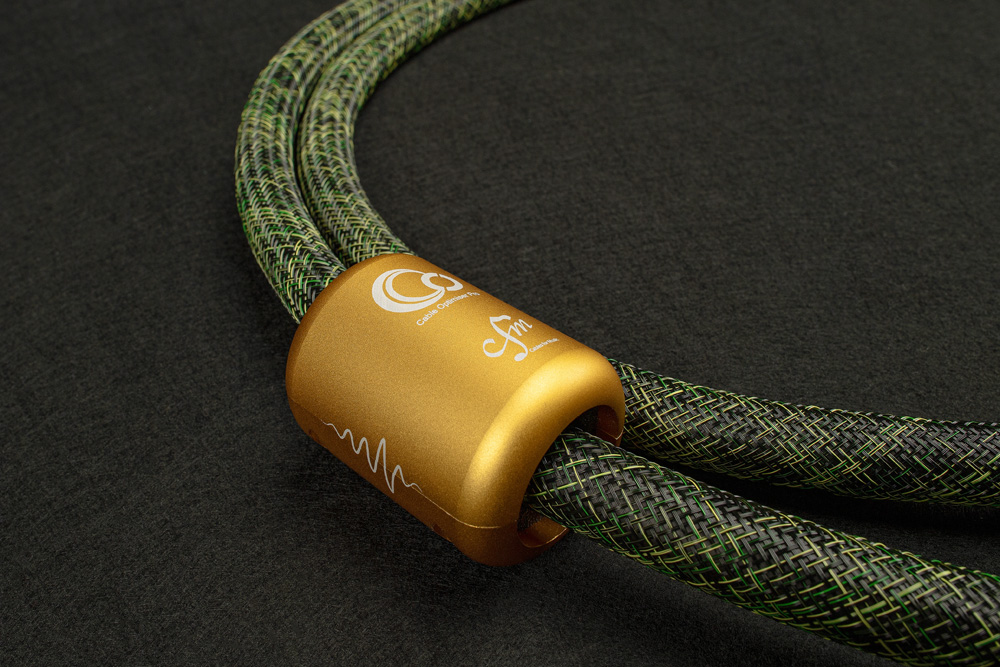
The second phase of the Resonant cable loom installation required the introduction of the wooden blocks. Aligned and oriented as instructed. I ended-up with all the cables being supported every couple of feet or so via the blocks. Re-listening to the above recordings and many more, I found the influence of the wooden blocks on my revealing system to be super subtle. In an effort to investigate further, I even bypassed my preamplifier and fed the power amplifier direct from the DAC which itself outputs directly from its R2R network – a more direct path you could not ask for. Despite the efforts, I could sometimes detect a subtle increase in the soundstage depth and height. Going back to non-block-support listening had me reneging on the previous statement. In my opinion, the cables shielding is so well executed and the standard red Cable Optimisers’ contribution so well-tuned that, in the context of my system’s considerable resolving power, I heard too subtle a contribution.
On the other hand (the third stage of the review), the large CO-P2 Cable Optimisers did bring more tangible fruit to bear. However, you’re not going to get… more. Not more bass, not more dynamics nor more resolution. What you will get, given a resolving-enough system, a little fine-tuning and a good, preferably treated, very quiet room acoustic, is potentially an improvement in certain aspects of reproduction. I’m confident I perceived a marginal but worthwhile extension of the soundfield (particularly stage depth) and a subtle improvement in transient attack. Again, the Resonant cable loom already excels comprehensively in these areas, in its standard guise. The CO-P2 offers a somewhat larger dimensional illusion to make the loom a hard to beat soundstage champ. There is a slight lowering of the noise floor – that hard to verbalise “background darkness” that audiophiles talk about. Again, my suspicion is that these add-ons may be system-dependent in terms of their maximum efficacy. Please, experiment within the context of your setup at length.
Conclusion
The audio cable market enjoys bountiful offerings from all around the globe, a factor which of course, provides abundant consumer choice. As wide as that choice is, the actual elements making up cable design are limited to ten or so vital aspects for consideration. There’s only a few ways to skin that cat.
Of course, there’s the conductor composition, and here, manufacturers are at the hands of the raw material suppliers, whether copper, silver, gold or composites of these. Conductor material can be drawn, simply cast or, better still, ‘Ohno Continuous Cast’ (a more costly process resulting in super-long material grain). Then, consideration needs to be given to the use of either solid core or multi-strand conductors, to the desired geometry (Litz, twisted pair, coaxial, etc.), shielding material, its construction and then dielectrics constitution.
The remainder, such as conductor isolation and the interrelationships between the different materials adopted in construction are important secondary aspects of cable design in the eyes of most cable makers. Not for CfM – these items are elevated to equal importance. Further, ground wire configuration, as CfM decrees, can be manipulated much as a chef embellishes with wisely-selected spices. The finer minutiae make the dish.
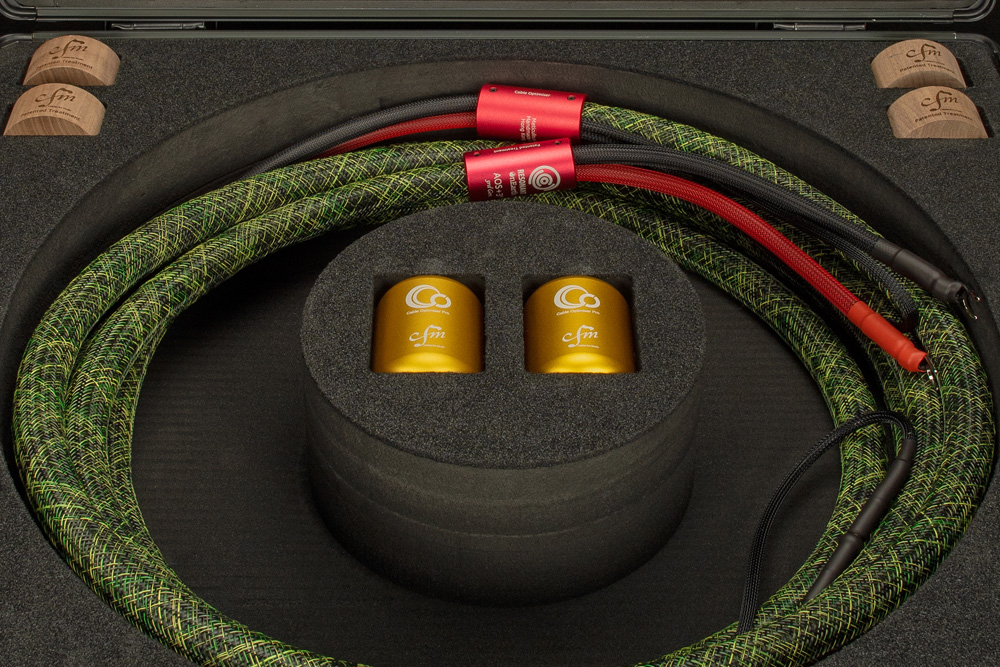
With the Resonant cables, CfM has used what some may call ‘tweaky’ components in an attempt to improve conductivity and maintain signal integrity. Yes, there’s an element of AC/DC here. Not the band, but my just-conceived ‘Audiophile Compulsive Differentiation Continuum’. If you suffer AC/DC malaise, you may find yourself futzing around with the wooden blocks and CO-P2 position and orientation ad nauseam. However, you can also set and forget.
With all bits in place, I found subtle benefits in terms of soundstage expansion and, perhaps as a result of an additive phenomenon, the Resonant loom’s overall performance is commensurate with some of the very best cables on the market. Plus, they most assuredly provide a point of difference from the industry’s legions of ‘same-same’ cable manufacturers.
So, there’s no more succinct way to wrap this up than to simply, and vehemently, state the Cables for Music unquestionably live up to their maker’s name. As the bard declared… Play on.
… Edgar Kramer
This email address is being protected from spambots. You need JavaScript enabled to view it.
Associated Equipment
- Speakers — Wilson Audio Alexia Series 2, Axis Loudspeakers VoiceBox S (nearfield monitor), Vermouth Audio Little Luccas Mk.II
- Amplifier — Gryphon Audio Antileon EVO
- Preamplifier — Supratek Cortese, Lightspeed Attenuator LDR passive
- Sources — Digital:432EVO High-End Music Server Roon Core, Yamaha CD-S2100 transport, Totaldac d1-direct DAC. Analogue: Transrotor Crescendo with Konstant Studio controller, Reed 1X Tonearm with upgraded internal wiring, Shelter Harmony cartridge, The Funk Firm Houdini cartridge decoupler, Supratek Cortese & REDGUM Audio RGPH2 phono stages
- Processor — DEQX PreMate
- Cables — Vermouth Audio Reference loom,Vermouth Audio Black Pearl Mk.II loom
- Audio Rack — SGR Audio Statement Model V
- Acoustic Treatment — Vicoustic Multifuser Wood, Wavewood Ultra, Cinema Round Premium and Super Bass Extreme
- Miscellaneous — GigaWatt PF-1 EVO, Les Davis Audio Viscoelastic CLD discs, VRC Vinyl Record Cleaning systemplus miscellaneous accessories
Cables for Music Resonant Cable Loom
Price: 1m Digital RCA AU$4576, 1.3m AES/EBU AU$5254, remainder TBA
Warranty: Five Years
Australian Distributor: Magenta Audio
+61 08 8390 1673
www.magentaaudio.com.au
Cables for Music
Room 801, 8th Floor, Shui Hing Centre
13 Sheung Yuet Road, Kowloon Bay
Kowloon, Hong Kong
+852 3990 0256
www.cablesfm.com






